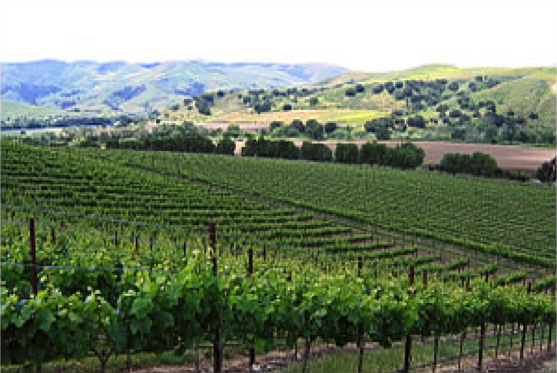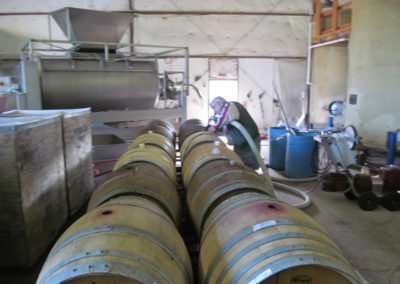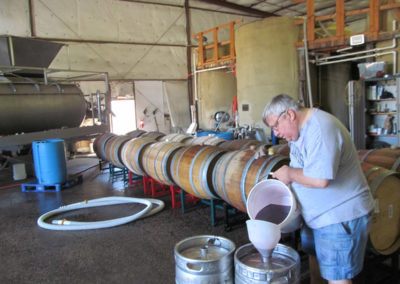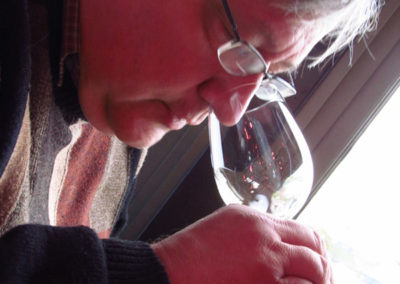WINE PRODUCTION
Rio Vista and the Vineyards of the Sta. Rita Hills
Blue Cape Cellars Pinot Noir has always been sourced from vineyards in the Sta. Rita Hills, mostly from the Rio Vista Vineyard. The Sta. Rita Hills appellation vineyards in California’s Santa Barbara County make up a small appellation – only about 100 square miles – extending about four miles west of Buellton, California to about two miles east of the town of Lompoc. The Santa Rita Hills are in the center of the Santa Barbara appellation, with vineyards lining Highway 246 to the north and other vineyards lining the Santa Ynez River valley and Santa Rosa Road to the south.
For our initial vintage (2012) our Pinot Noir came from two Sta. Rita Hills vineyards – Rio Vista and Hayes Ranch. Since then, we have only used Rio Vista fruit, selecting various clones we see fit for distinctive wine that expresses the unique terroir of this area.
The dominate soil series present are limestone, sedimentary soils and a marine layer of sandy loam. The Pinot Noir clones planted on the estate include 777, 2A, 115, 667, 828, Pommard and Calera.
Harvesting
Harvesting is the first step in the wine making process and an important part of ensuring delicious wine. Grapes are the only fruit that have the necessary acids, esters, and tannins to consistently make natural and stable wine. Tannins are textural elements that make the wine dry and add bitterness and astringency to the wine. They also have the right amount of sugar to produce a level of alcohol to make a wine with sufficient body and structure.
The moment the grapes are picked determines the potential acidity, sweetness, and flavor of the wine. Determining when to harvest requires a touch of science along with old fashioned tasting. The acidity and sweetness of the grapes should be in perfect balance, but harvesting also heavily depends on the weather. We try to pick at a sugar level (most commonly referred to as degrees Brix) around 23 to 25. We like the pH of the grapes to be around 3.3 to 3.5. This will affect the longevity of the wine.
Harvesting can be done by hand or mechanically. Many winemakers prefer to harvest by hand because mechanical harvesting can be tough on the grapes and the vineyard. Once the grapes are taken to the winery, they are sorted into bunches, and rotten, damaged or under ripe grapes are removed.
Crushing and Pressing
After the grapes are sorted, they are ready to be de-stemmed and crushed. For many years, men and women did this manually by stomping the grapes with their feet. Nowadays, most winemakers perform this mechanically. Mechanical presses crush the grapes and produce the “must.” Must is simply freshly pressed grape juice that contains the skins, seeds, and solids. Mechanical pressing has brought tremendous sanitary gain as well as increased the longevity and quality of the wine.
For white wine, the winemaker will quickly crush and press the grapes in order to separate the juice from the skins, seeds, and solids. This is to prevent unwanted color and tannins from leaching into the wine. Red wine, on the other hand, is left in contact with the skins to acquire flavor, color, and additional tannins.
Fermentation
After crushing and pressing, fermentation comes into play. Must (or juice with the skins and seeds floating in it) can begin fermenting naturally within 6-12 hours when aided with wild yeasts in the air. However, many winemakers intervene and add a commercial cultured yeast to ensure consistency and predict the end result. For our Blue Cape Cellars Pinot Noir, we use a slow fermenting yeast to ensure proper fermentation and desirable fruit profiles. Often a variety of yeasts are used.
Fermentation continues until all of the sugar is converted into alcohol and dry wine is produced. To create a sweet wine, winemakers will sometimes stop the process before all of the sugar is converted. Fermentation can take anywhere from 10 days to one month or more.
For most wines, there are two fermentations. Primary fermentation converts juice into alcohol and carbon dioxide. The latter is trapped in solution when making sparkling wines, providing the bubbles that escape into the wine after it is opened. The second fermentation is called “Malolactic fermentation” and is used to convert the tart malic acid in wine to the softer lactic acid. It is usually best to start this secondary fermentation after primary fermentation is finished. The winemaker can either introduce bacteria into the fermented wine to break down the malic acid or can use oak barrels that are “malolactic positive” and contain a previous fermentations bacteria to kick off the process. “ML” the winemaker’s jargon for this secondary fermentation process, can take several days. The end product is a wine that is less tart, soft in the mouth feel and quite aromatic.
Clarification
Once fermentation is complete, clarification begins. Natural clarification is the process in which solids such as dead yeast cells, tannins, and proteins precipitate from the body of juice (the fermented wine) are removed naturally. Another process is to transfer the wine, or “rack” it into a different vessel such as an oak barrel or a stainless steel tank, siphoning the juice from the barrel, leaving a good deal of the solids in the bottom or the original container. Wine can then be clarified through fining or filtration.
Aging and Bottling
Aging and bottling is the final stage of the wine making process. A winemaker has two options: bottle the wine right away or give the wine additional aging. Further aging can be done in the bottles, stainless steel tanks, or oak barrels.
Aging the wine in oak barrels will produce a smoother, rounder, and more vanilla flavored wine. The newer the oak, the more flavors imparted to the fermented wine inside the barrel, the older the barrel, the barrel wood has less effect on the aging wine but still allows an increase in the wine’s exposure to oxygen while it ages, which decreases tannin and helps the wine reach its optimal fruitiness. Steel tanks are commonly used for zesty white wines that do not need the effects of wood aging for their vibrant flavors.
After barrel aging, the wines are bottled and sealed with either a cork or a screw cap, depending on the wine maker’s preference.
How 6 wine lovers became wine makers
Check out Kim’s journey to becoming a winemaker. Kim’s story is on page 6.
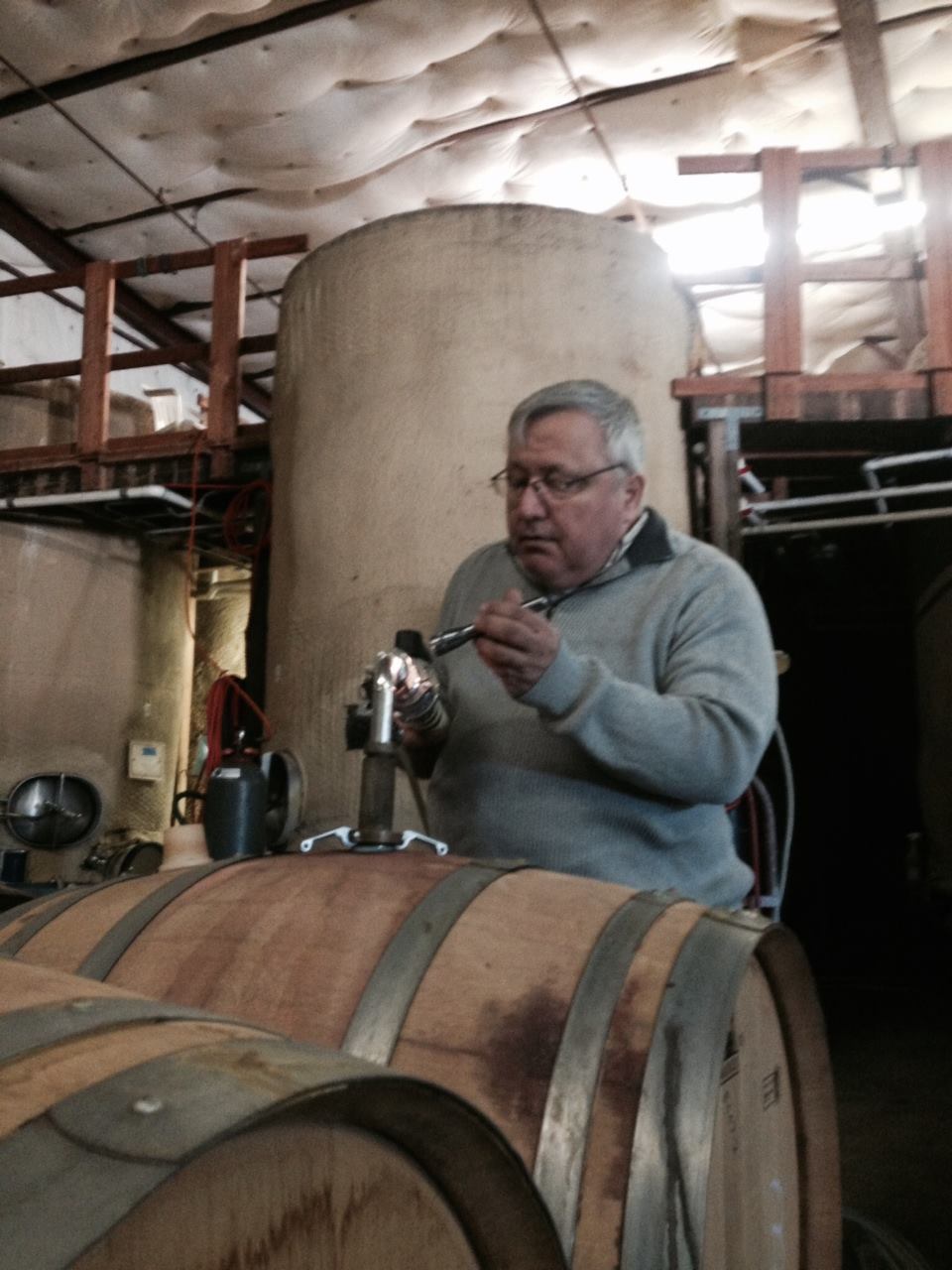
CONTACT US
We are available Monday - Friday, 9 a.m. to 5 p.m.
PHONE
602-690-5108
ADDRESS
3104 E. Camelback Rd. #1111
Phoenix, Arizona 85016

